| |
|
|
Interesting Tours
The Lori Region is rich with interesting and picturesque sites to plan day and overnight trips from Yerevan. In addition, a variety of hotels and restaurants in Lori provide accommodations for all tastes from the budget conscious to those who wish to indulge.
Sites of interest in the area include:
Old Dilijan Complex
The complex is situated in the town of Dilijan, which is known for its picturesque landscape, cozy feeling and many historic sites. Here you can enjoy activities such as shopping for crafts and souvenirs, taste traditional Armenian dishes, go for hike or just relax.
In late 19th, early 20th century, life in Dilijan went through many changes due to its scenic beauty and natural environment. Significant trade began with Baku, which at that time was the regional commercial center, as well as cultural exchange was established with Tblisi- cultural centre of the region; also, many rich families from these major cities started spending their vacations in Dilijan’s many summerhouses and guesthouses.
Two-storied tiled wooden homes with detailed carved balconies had become quite common as Dilijan’s typical architecture; some of which can still be seen on the historic Sharambeyan street, which has been restored by James Tufenkian. Sharambeyan street has been preserved as an “Old Town Dilijan” complete with craftsmen’s workshops, small shops with traditional Armenian products and crafts, museum, showing a typical 19th century home with all its locally made furnishings, guest house and a Tufenkian Restaurant.
Dilijan is blessed with a cool, moist climate, even in summer, and pleasant evergreen forests protected by a large nature reserve that wraps around the town and extends along the Getik River. Dilijan, a hamlet in the hills, reminds the unsuspecting visitor of Switzerland, with its characteristic forests and alpine meadows, natural mineral springs and beautiful landscapes. Beech and oak, as well as pine and yew are the object of environmental protection in the area. The National Park is the home to over 1000 species of plants and 107 species of birds, such as the Gushawk, Black Kite, Lesser Spottled Eagle, Honey Buzzard, and Eagle Owl.
Information courtesy of www.armeniainfo.am and www.tufenkianheritage.com
Haghartsin
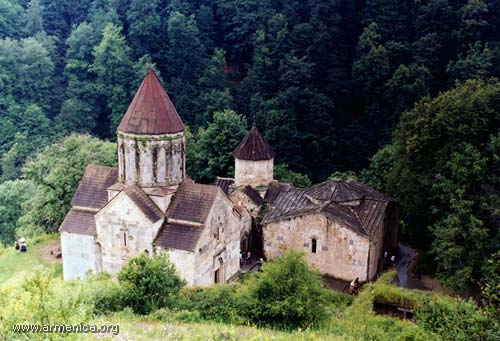
Haghartsin Monastery
This monastic group of buildings, near the town of Dilijan includes three churches, two gavits (one is ruins), a refectory, a group of chapels and several khatchkars. The principal church Sourb Astvatsatin was built in 1281 as a cupola structure with a tall drum. The south entrance is crowned with decorative moldings. All the walls, except the west one, have two triangular niches on the outside. The most ancient of the group is the church of Saint Grigor (11th century) with its cupola on an octagonal drum. A second near-by gavit is rectangular in shape and built in the 12th century. The small church of Saint Stepanos (1244), of the cupola type, is an elegant structure with finely worked motifs.
The refectory built in 1248 by the architect Minas, is one of the best representatives of medieval Armenian architecture: a structurally daring concept divided into a pair of communicating square halls, roofed with intersecting arches.
Information courtesy of www.armenica.org
Goshavank
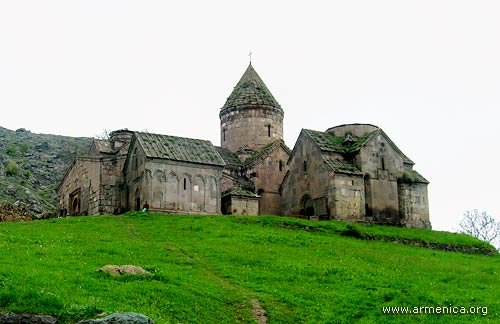
Goshavank Monastery
The Gosh monastery, formerly known as Nor Getik, is situated near the village of Gosh, on the eastern slope of the wooden valley of the Tand-zout, 23 km from the chief town of the region, Dilidjan. The monastery complex was founded in 1181, on the day its first church, dedicated to St Grigor Lousavoritch (the Illuminator), was inaugurated by the famous monk and legislator Mkhitar Gosh. The second church, in order of time, was the church of S. Karapet Hovnan. All that remains of these two buildings are the historical accounts of them written by Kirakos of Gandzak, a disciple of Mkhitar Gosh. The monastery complex, erected over a 116-year period, comprises the main church of St Astvatzatzin (1191-96), the smaller church of St Grigor (1209-31), the zhamatoun (1197), an ante-chapel used exclusively for burial purposes, the library (1291), the church of St Grigor Lousavoritch, built by Prince Grigor Tgha in 1231, and the refectory.
Information courtesy of www.armenica.org
Kobayr
Kobayr monastery is perched on a shelf of a gorge, in an ancient and sacred place where springs seep out of the rock. The monument of Kober was built in 1171 by the Kyurikian princes, but became a property of the Georgian Orthodox Zakarian family Most of the inscriptions are in Georgian. Shahnashah Zakarian is buried there. The bell tower in the middle of the complex was built in 1279 to house the tombs of Mkhargryel and his wife Vaneni.
Information courtesy of www.armeniainfo.am
Odzun
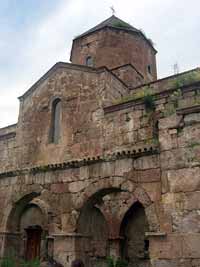
Odzun Monastery
The domed basilica in Odzun was built in the mid-6th century. At the center of an eastward-oriented rectangular space there are four solid pylons supporting a dome with an octahedral drum. Arch galleries extend on all facades except for the eastern one. Sculptural reliefs decorate the window ledges. The entire roof was rebuilt and small belfries were added in later years.
Information courtesy of www.armeniainfo.am
Sanahin
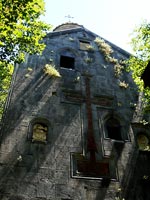
Sanahin Monastery
Haghpat monastery, one of the most resplendent in Armenian history, was founded by Saint Nishan at about the same time as the monastery of Sanahin during the 10th century. built between 976-991, is the principle church of the monastery. The clock-tower was erected in 1210 and is one of the most beautiful examples of its kind from the medieval period in Armenia. The monastery's bell tower, built in 1245, stands apart from the main ensemble of monuments, and is architecturally noteworthy. The two-storied structure's first floor is cross shaped, while the second is octangonal and crowned by a cupola resting on a series of elegant columns. The complex was once the home to libraries, scriptoriums, schools and refectories.
Sanahin Monastery is listed amoung the UNESCO World Heritage List (1996).
Information courtesy of www.armenica.org
Haghpat
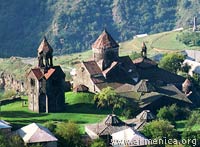
Haghpat Monastery
Haghpat monastery, one of the most resplendent in Armenian history, was founded by Saint Nishan at about the same time as the monastery of Sanahin during the 10th century. built between 976-991, is the principle church of the monastery. The clock-tower was erected in 1210 and is one of the most beautiful examples of its kind from the medieval period in Armenia. The monastery's bell tower, built in 1245, stands apart from the main ensemble of monuments, and is architecturally noteworthy. The two-storied structure's first floor is cross shaped, while the second is octangonal and crowned by a cupola resting on a series of elegant columns. The complex was once the home to libraries, scriptoriums, schools and refectories.
Haghpat Monastery is listed among the UNESCO World Heritage List (1996).
Information courtesy of www.armenica.org
Toumanian Museum
Founded in 1939 as a branch of E. Charentz Literature and Art Museum. For 59 years, the museum was managed by the niece of the poet Armenuhi Toumanian. The poet was born and spent his young years, as well as the last period of his life in this house. The building of the museum was restored with financial support of Diaspora Armenians Guntakjyan and Pujikyan. The museum collection contains close to 300 items. The patio has the bust of the poet (sculptor Aytzemnik Urartu) and a small chapel (architect R. Julhakyan) where the heart of the poet is buried.
Information courtesy of www.armeniainfo.am
12th Century Foot Bridge
The village of Sanahin is situated on the right bank of Debed River, near the town of Alaverdi and is connected to the main roads by a 12th century bridge, the oldest engineering construction in the area preserved to the present day.
Information courtesy of www.armeniainfo.am
|
|
|
|




